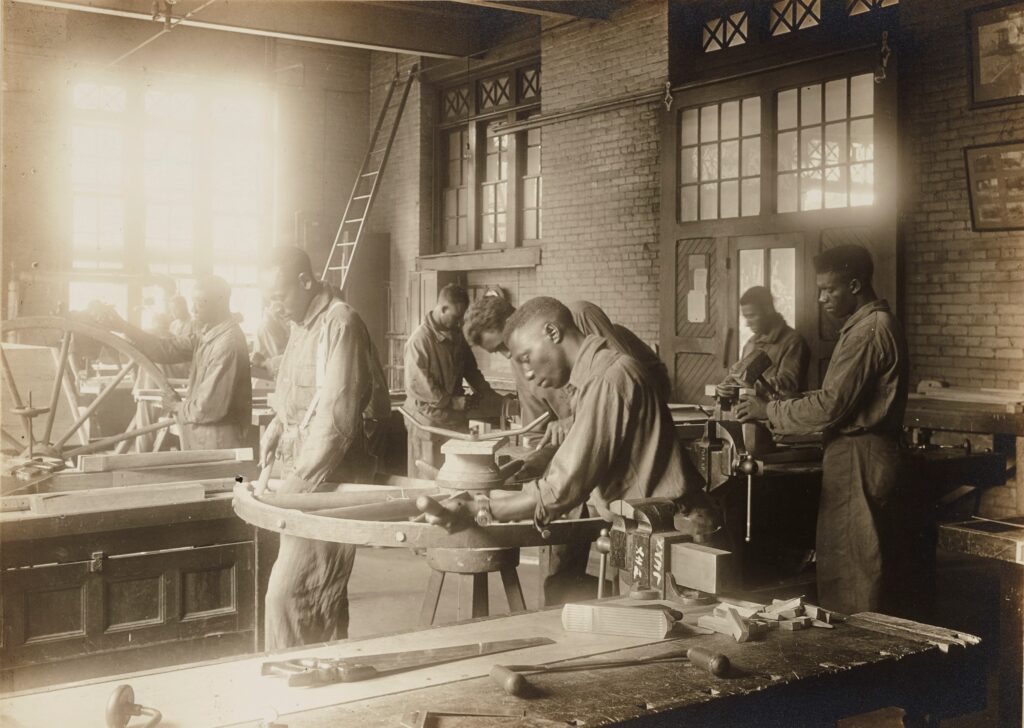National Training Detachments
The SATC was the result of combining several War Department efforts to increase troop production. In early 1918, the Committee on Education and Special Training (CEST) and its civilian Advisory Board was established by the War Department to investigate ways to acquire a satisfactory number of enlisted technicians for the Army. After several meetings beginning in February, the CEST decided to establish vocational programs, known as National Training Detachments, on college campuses with an initial start date in early April and continuing throughout the summer of 1918.1 These programs lasted eight weeks and provided instruction for a variety of trades necessary for the Army to function including electricians, mechanics, and telegram, telephone, and radio repairmen. Throughout the spring and summer of 1918, these National Training Detachments increased in size and expanded to more colleges including Historical Black Colleges and Universities, though a majority were at white institutions.2

The Students’ Army Training Corps
Developed concurrently with the National Training Detachments was the idea of finding a way to increase officer production for both frontline combat units and more specialized units. The Advisory Board first proposed the idea of using colleges to solve this problem in March 1918. In its proposal to the CEST, the Advisory Board suggested,
the establishment in all institutions of college grade of cadet reserve corps in which young men from 18 to 21 years of age might voluntarily enlist. It was further suggested that these students should receive military instruction, should maintain an academic standard higher than the pass mark, and should be enlisted, but on furlough status, hence liable to call to active service at any time.3
This plan was designed to replace the multiyear ROTC program and was approved by the CEST. On May 8, 1918, a letter from the Secretary of War, Newton D. Baker, was sent to the president of every college and university in the nation outlining this new program.4 This initial plan was given full approval by the Army General Staff on June 28, 1918, and was dubbed the Students’ Army Training Corps.5
After Congress expanded the draft age to as young as eighteen and as old as forty-five, the CEST revised its plan for the SATC, since many college aged men were now eligible for the draft. To prevent colleges from being drained of students and to keep the SATC on track, members of the SATC would receive pay, like regular soldiers, and would be considered full members of the military, preventing them from being drafted and sent to cantonments or Officer Training Camps.
Members of the SATC who were between the ages of eighteen and twenty would spend different amounts of time in the program, so that they would stay on track with when they would have been drafted. Twenty-year-old members would stay in the program for three months, nineteen-year-old members for six months, and eighteen-year-old members for nine months. This would mean that the twenty-year old members would finish their training in time to be sent to Europe for the planned 1919 spring offensive and the AEF would have a fresh batch of officers every three months as replacements. Conversely, SATC men could be sent to specialty units, such as the Coastal Artillery, as the need arose.
Finally, the CEST combined the vocational National Training Detachments with the collegiate SATC, with the collegiate group known as the A Section of the SATC and the vocational group known as the B Section. With this new plan, the SATC inducted its first members on October 1, 1918.7
Notes:
- The Advisory Board, Committee on Education and Special Training. A Review of Its Works during 1918 (Washington, 1919), 13–14, https://catalog.hathitrust.org/Record/000488027.
- The Advisory Board, 18–20.
- The Advisory Board, 22.
- War Department Memo to College Presidents dated May 8, 1918, Box SF047, Folder WWI Training Camps 1917, World War I Students’ Army Training Corps (SATC) and Training Camps Records, 1917-1919, Office of the Superintendent, administrative subject files, Virginia Military Institute Archives, Lexington, VA.
- The Advisory Board, Committee on Education and Special Training. A Review of Its Works during 1918, 22.
- War Department Memo to College Presidents dated May 8, 1918, Box SF047, Folder WWI Training Camps 1917, World War I Students’ Army Training Corps (SATC) and Training Camps Records, 1917-1919, Office of the Superintendent, administrative subject files, Virginia Military Institute Archives, Lexington, VA.
- The Advisory Board, 24–25.